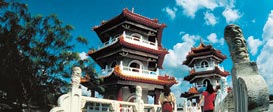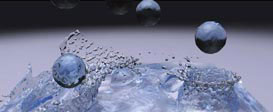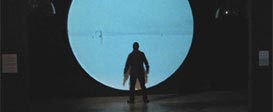Technical Papers
- The Technical Papers submission deadline was 28 May 2008.
- Frequently Asked Questions
- Detailed Instructions & Checklist
- Format Requirements
- Review Process
The Technical Papers Committee and a set of external reviewers, both consisting of recognised experts, will review submitted papers. Then, at their meeting (9-10 August 2008), the committee will select those papers to be presented at SIGGRAPH Asia 2008 and published in a special issue of ACM Transactions on Graphics.
SIGGRAPH Asia 2008 is an ACM SIGGRAPH conference, but it is distinct from the long and ongoing series of SIGGRAPH conferences that have been held in the United States. As such it faces new challenges, especially in the definition of its review process. The SIGGRAPH Asia 2008 process is patterned on the review processes of previous SIGGRAPH conferences, but it does not match exactly the process employed by SIGGRAPH 2008. To ensure the transparency of the SIGGRAPH Asia 2008 review process, a full and detailed description is provided here, including the names of everyone involved and how they were chosen.
Who is the Committee?
The Technical Papers Committee consists of (1) the Technical Papers Chair, who was chosen by the SIGGRAPH Asia 2008 Conference Chair and approved by the ACM SIGGRAPH Executive Committee and its Conference Advisory Group; (2) the Technical Papers Advisory Board, consisting of the SIGGRAPH Asia 2008 Technical Papers Chair, the SIGGRAPH Asia 2009 Technical Papers Chair, and six other people, some selected by the ACM SIGGRAPH Executive Committee prior to the selection of the Technical Papers Chair, and some selected later by the Technical Papers Chair; and (3) the Technical Papers Committee, chosen by the Technical Papers Chair with the assistance of the members of the Technical Papers Advisory Board, and consisting of about 25 people whose expertise spans the entire field.
Technical Papers Chair
Kurt Akeley
Technical Papers Committee
John Anderson
Ken Anjyo
Kavita Bala
Yung-Yu Chuang
Danny Cohen-Or
Doug DeCarlo
Tony DeRose
Tom Funkhouser (SIGGRAPH 2009 Technical Papers Chair)
Markus Gross
John Hart
Aaron Hertzmann
John Hughes
Greg Humphreys
Doug James
Tao Ju
Sing Bing Kang
David Kirk
Hyeong-Seok Ko
Johannes Kopf
Subodh Kumar
Jehee Lee
Dinesh Manocha
Nelson Max (SIGGRAPH Asia 2009 Technical Papers Chair)
Carol O'Sullivan
Hanspeter Pfister
Marc Pollefeys
Doug Roble
Holly Rushmeier
Pete Shirley
Mel Slater
Chi Keung Tang
Xin Tong
Geoff Wyvill
Jianmin Zheng
Kun Zhou
In publishing this information, we are trusting the community not to abuse this knowledge. For example, if one week before the submission deadline you send your manuscript to a Technical Papers Committee member with whom you are not already collaborating on that research, in hopes of getting useful advice or of circumventing author anonymity, you may cause that committee member to declare a conflict on your paper, you may annoy the person, and you may develop a reputation for lobbying, none of which will help your paper get accepted by SIGGRAPH Asia 2008. We also discourage authors from giving colloquia in the last weeks before the submission deadline to Technical Papers Committee members with whom they are not already collaborating.
In general, although search engines make it a simple matter to find email addresses for these people, we ask that you do not contact them directly about the review process. Instead, please use the SIGGRAPH Asia 2008 Technical Papers Email Contact Form, which sends messages to the Technical Papers Chair, the Technical Papers Advisory Board, and selected administrators of the papers review process.
Phases of the Review Process
The Technical Papers Committee will categorise papers using a six-phase process:
1. The weekend following the submission deadline, the Technical Papers Chair and several of the members of the Technical Papers Advisory Board convene to sort the papers. During this meeting, they assign papers to two senior reviewers, who are members of the Technical Papers Committee. In addition to helping with the sort, members of the Advisory Board may themselves serve as senior reviewers for a few papers. The Technical Papers Chair does not review papers. Papers that are inappropriate may be rejected during this assignment process, without being sent to any senior reviewers. Papers will normally be rejected at this stage only if they are clearly off-topic for SIGGRAPH Asia 2008, or if they are discovered to have been published previously or to have been submitted simultaneously to another conference or journal. However, if more papers than expected are submitted, the criteria for pre-assignment rejection may be broadened at the discretion of the Technical Papers Chair. For more details, see Prior Art & Public Disclosure and the Double Submissions section of Frequently Asked Questions.
2. The two assigned senior reviewers may, upon conferring with each other and the Technical Papers Chair, recommend a paper to be rejected without additional review. A paper will normally be rejected at this stage only if it falls into one of the categories listed in phase one, but this fact was not detected during the papers sort. It is possible, although unlikely, that a paper may also be rejected at this stage if it solves a problem that is known to be already solved; or if it does not cite (and the authors seem unaware of) important prior work on the same problem and doesn't address how it is different; or if it has no evaluation via proof, experiment, or analysis; or if it is solving a problem sufficiently minor that the senior reviewers do not believe that it belongs in the program.
3. Each paper is distributed to three or more additional experts. Two of them are selected by the primary senior reviewer of that paper, and the third is selected by the secondary senior reviewer. The primary, secondary, and tertiary reviewers all write full reviews. (A copy of the review form can be found here and reviewer instructions here.) Thus, at least five reviews are written for each paper that has not been rejected during phases one and two. The senior reviewers know the identities of the authors of the paper, but the tertiary reviewers do not. In unusual cases, such as when a tertiary reviewer fails to deliver a review on time, papers may receive only four reviews. However, if a paper receives fewer than four reviews, additional reviewers will be found, possibly from the committee. For more details, see the Review Process section of Frequently Asked Questions.
4. After all reviews are complete, the review system allows the authors access to the reviews and scores for their papers. The authors have five days, from 28 July 2008 through 1 August 2008, to enter rebuttals if they feel that the reviewers have made substantive errors, or to answer specific questions posed by the reviewers. The initial rebuttal is confined to 2,000 words in length. At the option of the senior reviewers, the authors may be permitted to upload text in excess of 2,000 words, or other material, including images or video, during the rebuttal period. Note: The rebuttal period is for addressing factual errors in the reviews, not for getting revised text or new results into the review process. Any such novel material will be ignored by the senior reviewers. For more details see the Rebuttal Process section of Frequently Asked Questions.
5. Between the end of the rebuttal submission on 1 August 2008 and the committee meeting, 9-10 August 2008, the senior reviewers will read the author rebuttals, confer intensively about the paper, and prepare a recommendation for the committee meeting. During this phase, more information, including images or video, might be requested of the authors by the senior reviewers. The three tertiary reviewers will see the author rebuttals and will participate in discussion of the paper. Since the three tertiary reviewers do not know the names of the authors, the authors should maintain anonymity in their rebuttals and in their responses to queries by the senior reviewers. In addition, the tertiary reviewers don't know each other's identities, so they too must maintain anonymity during the discussion.
6. The full Technical Papers Committee meets 9-10 August to determine acceptance or rejection of each paper. In cases where a consensus on a paper was not reached during the pre-meeting discussion phase, additional committee members may read the paper, and their evaluations will be taken into account in the decision. In some cases these additional readers will submit full reviews, which will be returned to the authors following the committee meeting. In instances where the reviews vary widely, the committee's deliberations may be summarized by a senior reviewer in one or two paragraphs, which will be returned to the authors following the meeting.
Although the senior reviewers of a paper know the identities of its authors, they normally do not disclose these identities during the meeting. Papers are judged solely on their merit, as determined by the reviews. Although the acceptance rate of SIGGRAPH papers has remained nearly constant in the range of 15% to 20%, there is no quota for the number of papers that should be accepted by the SIGGRAPH Asia 2008 Technical Papers Committee; this number will arise organically from the actions of the committee.
Possible Outcomes for a Paper
At the committee meeting, each paper is placed in one of three categories:
1. Rejected
2. Conditionally accepted for presentation at SIGGRAPH Asia 2008, possibly pending minor revisions. Conditionally accepted papers undergo a second reviewing process, in which a referee (a member of the Technical Papers Committee) verifies that the final version of the paper is acceptable (that any minor required changes have been made, and that other changes made by the authors, perhaps in response to reviewer comments, have not compromised the paper in any way). This second and final stage determines the final acceptance status of all papers. The referees' decisions are final. Papers that do not satisfy the referees in the second stage of reviewing and that are not provided in camera-ready form by the final deadline will be rejected. Accepted papers will appear in the conference proceedings, which will be published as a special issue of ACM Transactions on Graphics.
3. Conditionally accepted for publication in ACM Transactions on Graphics, pending major revisions. At the authors' discretion, these papers undergo a second reviewing process, in which an Associate Editor of ACM Transactions on Graphics works with the authors to produce an acceptable final version of their papers. These papers will be published in regular issues of ACM Transactions on Graphics.
Authors will receive email notifications of this outcome not later than 22:00 UTC/GMT on Monday, 11 August 2008.









